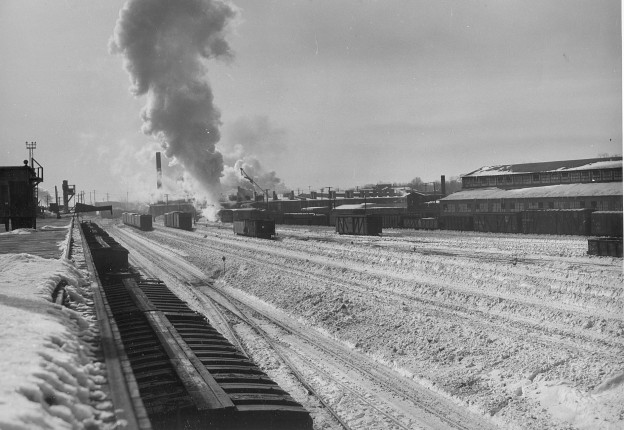
The Maybrook Yard of the Central New England Railway may be practically vacant today, but it was once a magnificent landmark of the east coast. The yard’s origins can be traced back to the late 1800’s, when a railroad bridge crossing the Hudson at Poughkeepsie was conceived. Though not put into service until 1888, construction began on this bridge in 1871, and a railroad was concurrently built to connect its western end with Campbell Hall. This means that what is now Maybrook was originally intended to be located much closer to Campbell Hall – but due to local farmers’ fears of the railroad, it was instead built where it is today. So the line was built almost as planned, ending at Orange Junction (the area now known as Maybrook). The railway line from Highland to Orange Junction was operated by the Philadelphia, Reading, and New England Railroad until 1898, when it was taken over by the Central New England Railroad.
The Central New England Railroad chose to place its administrative office on this newly acquired line, and built a two-story building at the end of Main Street to house it. The railroad built a number of residences in the vicinity of the building as well to house its employees. These residences coupled with others from the Orange County Railroad (which maintained a few tracks on the line) were the building blocks for the village of Maybrook, though the area was not incorporated as a village until somewhere between 1925-1926 With these improvements, the line continued to run successfully under its new ownership.
In the year 1906, The New York, New Haven, and Hartford Railroad acquired half of the interest in the Central New England Railroad’s operation at Orange Junction. This eventually led to plans in 1908 to build what would become the largest switching terminal east of the Mississippi. This terminal would be three miles long and one mile wide, stretching all the way from Main Street to Route 17K. It would contain a wide variety of establishments, from train car repair shops, to an ice manufacturing plant (for refrigerator cars), even including a Y.M.C.A. and an auditorium. The terminal was the most magnificent of its kind in the Northeast, though it has since been dwarfed by others.
The majestic terminal reached its peak during World War II. At this point, trains were leaving and entering the terminal to and from Chicago at every hour, and it boasted fifteen hundred employees with a payroll of $150,000. The terminal even set a switching record in May of 1943, with twenty-five eastbound trains (a total of 1665 cars) and twenty-nine westbound trains (a total of 1826 cars) switched and reassembled in a period of two hours. The terminal boomed for decades, seeing much success and being used to its full and ideal potential.
Then, in 1974, disaster struck when a fire destroyed three hundred feet of the Poughkeepsie bridge (known today as the Walkway Over the Hudson). The bridge stands at a bit of a downward angle, and so travel here would require trains to brake. It is quite likely a spark generated by this braking that began the fire that destroyed the bridge and ultimately led to the terminal’s downfall. Repairs to the bridge were refused by the railroads, with the focus instead simply placed on other ventures. With its only means of transporting outbound traffic destroyed, the terminal was all but doomed.
The line itself saw a brief rebirth when the New York Susquehanna and Western Railway began using it to run trains between New Jersey and Binghamton around 1985-1986. At this point the line was under the ownership of the Consolidated Rail Corporation (Conrail for short), but was a shadow of its former self. Very few trains were run on the line, and their time was monopolized by hours of car reconfiguration (much in contrast to the terminal’s glory days, when the switching record was set). Eventually, a connector to the Erie line was built at Campbell Hall in 1988, as was originally planned a century earlier. The Maybrook Yard and its line became obsolete, and fell into practical vacancy.
All that remains of the once-magnificent railway yard today is a lone track, used to service a few industrial plants. Today, the lot that once housed the greatest train terminal this side of the Mississippi sits empty and barely used, neglected by time and misfortune. A mere forty-four acres of the property are owned and used by Yellow Freight, and the back side of the lot and a reservoir are still owned by the MTA. The rest of the property is left alone. There is not even an abundance of pictures left to remember the Yard by, as those who knew it in its heyday thought it would last forever. The only photos left come from a fortuitous, annual stop by a photographer’s train years ago – but these pictures are scarce, and they are precious.
I was granted the privilege of a short interview with local resident Shirley Bullis, who remembers the terminal in its prime. At the peak of the terminal’s operation Shirley worked for the O & W Railroad in Middletown, but holds fond memories of the “big booming railroad” that was the Maybrook Yard. She recalls traversing the “treacherous tracks” on her way home from work, recalls her boys exploring the ice house, and even recalls once owning a diner just across the tracks. When I asked Shirley for a quote that would sum up the magnificence of the track in its heyday, I learned that this is impossible. There is no way to sum the terminal in one phrase, she told me, save for the fact that it was “beyond belief.”
Contributed by John Kidd


